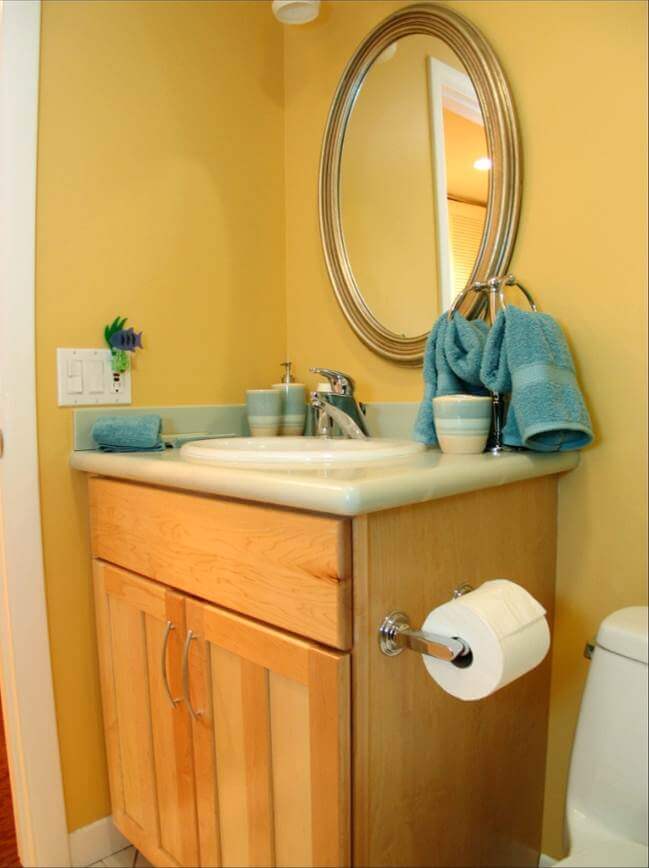When every inch counts, you will want to consider getting professional design help from a kitchen and bath designer or design/build remodeling firm to get you started. Here are a few tips from our design consultants:
The first thing you want to tackle is figuring out how much space you have to work with. There are a multitude of ways to make a small space appear larger than it is. For example, use a pocket door, rather than a standard hinged door. When choosing mirrors, use one large one instead of two. Go with light-colored finish materials and clear-glass shower doors to stretch space visually.
Storage space usually is at a premium in small baths, so consider recessing a bath cabinet above the vanity. Many vanities have only two front doors offering limited storage space with no room for organization. So, look for a vanity with drawers or bins for toiletries and cleaning supplies your bathroom remodeler should be able to add drawers or shelving to most cabinet orders.
Finally, avoid pedestal sinks in a small, full bath. They look great but are impractical because they don’t provide storage. Save them for powder rooms where storage isn’t as crucial.
Keep it Affordable
How much will a small bath remodel cost? That depends on structural changes and the price of the components. The National Kitchen and Bath Association’s annual Trends Survey†puts the cost of a basic bathroom remodel at about $9,000. But remember, it’s easy to exceed that amount by picking high-end materials.
For example, a deluxe whirlpool tub may cost $5,000, whereas the same tub minus the whirlpool might be $1,200. A designer or more decorative sink can be a $500 investment whereas a simple white china version costs $70.
Another important factor in the final tally is the cost of labor. Because all the major building trades are involved in a bathroom remodel, sprucing up even a small bath tends to be expensive if you hire out all the work.
No matter how small a bathroom you’re planning, it must include certain items. Ground-fault circuit interrupters (GFCIs) are required by code to protect receptacles in wet areas, such as bathrooms and kitchens. GFCIs quickly break the circuit, which can prevent a potentially fatal shock from a blow-dryer or electric shaver.
Low-flow toilets, which use 1.6 gal. of water per flush (and soon-to-be 1.28 gal.), are required by law in all new and remodeled baths. Pressure-assisted toilets effectively clear the bowl with one flush, but make considerable noise in the process. Gravity models sometimes require two flushes to clean the bowl properly. For maximum efficiency, choose a bowl with a large water surface.
Proper ventilation will prevent moisture from getting trapped in the bath, which can lead to mold and mildew growth. This moisture can also destroy wall coverings, harm wallboard and other building components and saturate insulation, rendering it useless.
Adequate lighting is needed for shaving, applying and removing makeup and other grooming tasks. Include task-specific and ambient, or general, light. Multiple recessed ceiling fixtures are all but invisible and eliminate the locker-room look of a single ceiling-mounted fixture. Include a light fixture above the tub and/or in the shower.
Finally, admitting natural light with skylights, etched glass, transom windows and glass block is an effective way to maintain privacy without taking up additional space. At a minimum, window area should equal at least 10 percent of the square footage of the room.
Seem like a lot to remember? Your design consultant is there it help you pick the options that are best for your small space whether it be a bathroom or kitchen.You may think that the only possibility for you bathroom is to remove the existing and put it back the exact way you had it, just with new materials. Make sure you ask your design consultant what other options you have. You’ll be surprised with what they come up with!

